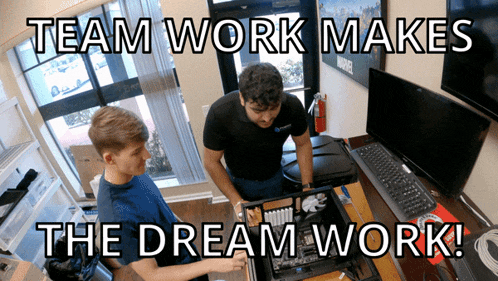Learn to correctly assign tasks to subordinates: 5 simple steps
-
Anton Koval
Copywriter Elbuz
Have you ever wondered why some teams succeed and others don't? It's all about **how** you assign tasks to your subordinates. A well-formatted task can inspire, organize and direct employees towards a common goal. But one wrong word and all your work can go to waste. Clear goal setting is not just a formality. This is the key to high productivity and effective team work. Imagine a ship captain telling the crew to “sail somewhere.” What will come of this? Most likely, a collision with reefs and loss of course. Questions arise: what exactly to do? How to get the desired result? When should this be done? And most importantly, how to properly manage your team? To find out the answers to these questions, read on!

Glossary
📝 Clear statement of tasks - Clear and specific tasks that eliminate ambiguity and improve team performance.
🚫 Bad boss - A manager who doesn't knows how to effectively set tasks, which leads to confusion, decreased motivation and productivity.
⏰ Time Limit - Established due dates tasks, allowing the employee to plan his time and priorities.
📏 Measurable Objectives - Defined objectives of the task, which can be quantified, allowing for monitoring and evaluation of implementation.
💡 Achievable Goals - Realistic and achievable goals taking into account the available resources and competencies of employees.
📅 Long-term goals - Goals and tasks, that require a long time to complete, such as developing a new strategy or product.
📊 Current tasks - Operational tasks that must be completed during the current workweek or month.
🗓️ Daily tasks - Regular tasks that must be performed every day to maintain workflow and prompt completion of duties.
🌟 Ideal problem — Problem formulated as much as possible clear and understandable, with specific parameters, deadlines and measurable results.
🗨️ Subordination - Rules and norms of interaction between managers and subordinates, based on hierarchy and respect.
📍 Task recipients - Employees or groups, to whom tasks are assigned; It is important to correctly identify those who are most competent to perform certain tasks.
🏆 Motivation and Praise - Positive influence on employees through recognition of their achievements and encouragement, which helps to increase their involvement and effectiveness.
✔️ Useful tips for entrepreneurs - Recommendations and methods to improve task setting and team management to achieve optimal results.
Important Long-Term Objectives
When I took responsibility for a large project to bring the company into the TOP 10 online stores in its segment, I realized how important long-term goals are. And I want to share with you exactly how this can be done effectively. Without setting these tasks correctly, the project risks getting stuck or failing altogether. I believe that it is important to pay attention not only to the formulation of goals, but also to the creation of a suitable atmosphere for discussing them.

Setting a clear and specific long-term goal helps the team understand where we are going and what steps are necessary to achieve the goal. For example, when we decided to increase revenue to a million per month, we defined specific metrics and milestones that needed to be completed along the way. We were also careful to ensure that resources were allocated correctly and that each team member understood their role.
These tasks require a thoughtful approach and in-depth analysis. There is no need to impose them in regular meetings. To do this, we organized strategic sessions with the participation of key persons of the company, which made it possible to discuss all aspects in more detail.
Preparing to effectively discuss long-term goals:
- 📋 Create a detailed plan with time frames and control points.
- 🧑💼 Make sure all stakeholders are aligned with the same vision.
- 📊 Regularly monitor and adjust the plan depending on changes in the external environment.
When we implemented this system, our team began to consistently achieve our goals, which brought financial stability and improved social initiatives of our business.
.gif)
| What to do | What to avoid |
|---|---|
| Create specific and measurable goals | Define goals vague |
| Include all stakeholders | Leave key persons outside the discussion |
| Review plans regularly | Forget about regular checks and adjustments |
| Take into account external changes | Ignore influence of external factors |
Important current tasks
When I am faced with a task that can be done tomorrow, but it is better not to put it off, I approach it with full attention. For example, in my practice there have often been cases where changing a supplier required much more time and preparation than I initially thought. Therefore, it is important not to waste time, but to begin such tasks in advance.

I advise you, like myself, to carefully plan even those tasks which seem insignificant at first glance. Preparation includes everything from analyzing current conditions to negotiating and concluding contracts. For example, changing the courier service turned out to be decisive for us in terms of delivery times and customer satisfaction.
To successfully cope with important current tasks, I recommend:
- 📆 Create a clear schedule completing tasks.
- 💬 Constantly communicate with the team about progress.
- 📑 Document all changes and results.
In my experience, when we moved ahead with supplier changes a little early, we were able to minimize production delays and improve product delivery.
Daily tasks
In the daily hustle and bustle, I do not forget about the small tasks that I set for my employees every day. These are exactly the tasks that may seem insignificant, but they form the entire process of the company’s work. For example, when I ask managers to call clients or send out mailings, I understand the importance of these actions in maintaining contact and increasing sales.

I believe that it is important to coordinate the actions of employees so that each link acts as efficiently as possible effective:
- 📞 Provide detailed instructions on each call.
- 📨 Monitor the quality of the completed mailing.
- 📝 Conduct regular checks on daily tasks.
I have found that paying attention to these daily tasks increases overall customer satisfaction and promotes business growth.
Other tasks
There are tasks that can be postponed relegated to the background or third place without critical consequences. For example, moving to a new office or buying a coffee machine. And although this is important, I still don’t put such tasks as a priority if it’s not on fire.

But since corporate events are always important for maintaining team spirit, this is an exception. Organizing such events requires preparation and planning. I am always convinced of this, especially when it comes to large corporate parties that unite the team and increase its morale.
How I distributed tasks so as not to neglect less urgent needs:
- 🏢 Moving to The new office was planned for a period of downturn in work.
- ☕ Synchronized the purchase of new equipment with the current budgetary possibilities.
- 🎉 I planned the organization of the corporate event on a predetermined date for maximum team participation.
This way, other tasks become more manageable and don't distract from your current priorities.
What a bad boss does
Now let's move on to the important question - what not to do. An example of poor leadership may be the clearest indicator. One of the bosses I encountered lumped everything together, mixing the important and the unimportant.
For example, an important project could be sacrificed for a small corporate event. This led to highly qualified employees wasting their time inefficiently, which ultimately impacted the productivity of the entire team.

So, I don't advise anyone to go down this path:
- 🌀 Do not mix tasks of different importance.
- 🚫 Don't sacrifice important projects for the sake of little things.
- 📉 Don't forget about long-term goals for the sake of short-term prospects.
When I realized this from my own experience, it became clear to me how critical it is to get it right distribution of priorities for the success of the company.
By following these simple rules and focusing on good goal setting, you can avoid performance degradation and improve team performance.
Clear and unambiguous task setting
Every successful leader At least once in my work I encountered the problem of incorrect interpretation of tasks by subordinates. One day I asked one of my managers to make a simple call to a client. He ended up calling the wrong customer and discussing a completely different issue than I had in mind. This clearly illustrates that tasks should be formulated as clearly and unambiguously as possible.

🗂️ Examples:
- 🚀 Specifics. Instead of “call the client,” I advise you to be more specific: “call Ostap Ibrahimovic from the Horns and Hooves company and clarify the details of the contract.” This helps avoid misunderstandings.
- 📝 Detail. Non-vague instructions are always more effective: “once the call ends, email me the report.”
A clearly defined task is the key to high results.

📊 Summary:
| Do | Don't |
|---|---|
| Full task description | Blurry instructions |
| Approximate timing | No indication of completion time |
| Specifics | Generality |
On at the next planning meeting you can discuss the clarity and unambiguity of task statements with your team.
How to assign tasks to subordinates: 7 simple steps
📅 Step#1: Choose a time and place
Choosing the right time and place to set goals is the most important step in ways to effectively delegate. I've found that the best time to hand out tasks is during operational meetings. In such conditions, employees are in a working mood, fully ready to listen to you and write down information. This not only provides structure to their day, but also creates an atmosphere in which they are most receptive to new tasks. It is important to make sure that the person you are about to assign the task to has your full attention at that moment.

❌ What a bad boss does
An example of the wrong approach is when a manager suddenly bursts into the office and starts issuing tasks without taking into account the availability of employees. I can safely say that this method leads to disorganization and decreased productivity. I have seen many cases where managers were unable to complete tasks simply because they did not have time to understand them correctly under such stress.
🏢 Step#2: Maintain subordination
Social Team structure is a key component of successful work. I remember a case from practice when the distribution of instructions directly to sales managers bypassed their manager, which led to complete confusion. I always advise distributing tasks through department heads in order to maintain a clear hierarchy and eliminate possible misunderstandings. The most effective way is “my vassal’s vassal is not my vassal.”
✏️ What a bad boss does
Unfortunate boss I’m used to distributing tasks to everyone, regardless of the hierarchy. He compassionately leads cleaners, managers and drivers as equals. This not only destroys chain of command, but also creates conditions for chaos. I am sure that with this approach, work efficiency drops rapidly.

🎯 Step#3: Choose your recipients wisely
One of the important rules is the correct targeting of tasks depending on their urgency and strategic importance. I once had to correct a situation where strategic tasks were assigned to a junior manager - this caused delays and errors. I always advise holding meetings of founders or partners to resolve key issues and carefully prepare for them.
🚬 How a bad boss works
You can often observe a situation where a manager who does not know how to delegate effectively solves all tasks independently or distributes them to everyone. Often such bosses complain about being eternally busy and realize their ineffectiveness only after the fact. I am convinced that delegation requires skillful distribution of tasks and the right choice of performers.
🔍 Step#4: Assign responsibility
I always appointed specific individuals to perform tasks and did this with an emphasis on a clear distribution of authority. For example, I once missed assigning someone responsible for a certain task, and this led to its failure. Those responsible must not only be appointed, but also notified about this. It is best if a protocol with names is drawn up following the meeting.
🙌Step#5: Praise and motivate staff
One day I realized the importance of a simple “thank you” when I stopped being stingy with praise and noticed a dramatic improvement in employee motivation and productivity. Praising a job well done is not only the right thing to do, it is also necessary to create a healthy work environment. I advise praising employees not only for the completed project, but also for previous achievements, this motivates them to new achievements.

Review table:
Useful practices Ineffective practices Hold meetings to set tasks Hand out tasks in chaotic environments Maintain chain of command Ignore hierarchy Assign responsibility Assign tasks to everyone Praise and motivate Neglect praise
🎓Effective management is an art that requires a wise approach from the leader to each stage of delegation. I can confidently say that following these steps will help you create a team that works like a cohesive machine.
The importance of clear goal setting and how to avoid common mistakes
In my practice, I have repeatedly observed how inappropriate goal setting leads to dissatisfaction among employees and decreased productivity of the entire team. I can confidently say that clearly setting goals and expectations is the key to success. Below I will explain the main mistakes that managers often make and how they can be avoided.

Common mistakes and their impact on team performance
📌 Uncertainty of tasks
When tasks are formulated too vaguely or unclear, subordinates may not understand what exactly is required of them. This leads to misunderstandings and reduced work efficiency. I can confidently say that specific and measurable goals always lead to better results.🤷♂️ No deadlines
Tasks without clearly defined deadlines are often put off until later. Setting specific deadlines creates discipline and allows you to better plan your working time. I always recommend setting realistic deadlines to avoid deadlines that are impossible to achieve.🎭 Failure to take into account the personal characteristics of employees
Distributing tasks without taking into account the strengths and weaknesses of subordinates can become a source of stress and job dissatisfaction. Taking into account the individual skills and preferences of employees, I always try to distribute tasks so that they best suit their professional level.📉 No feedback
By failing to provide timely feedback, leaders miss opportunities to course-correct and motivate employees. Regular feedback helps to identify problems at an early stage and solve them in a timely manner. I am convinced that regularly checking in on tasks and discussing the results helps maintain a high level of motivation.

Examples successful delegation
In one of my previous projects, I was able to organize the work of the team so that all tasks were completed on time and with excellent quality. Here are a few steps I used:
Clear task description
I always try to formulate tasks as specifically and clearly as possible. For example, instead of “Complete the report by Friday,” it would be better to say, “Prepare the sales report for the last quarter, including data for each product category, by 5:00 pm on Friday.”Setting deadlines
I always set clear deadlines for completing a task and explain why this particular deadline is important. This helps avoid doubts and procrastination.Appointment of responsible person
I define a specific employee responsible for completing the task. This eliminates the blurring of responsibility and allows the employee to clearly understand his obligations.

Regularly reviewing task progress
I hold regular meetings with the team to discuss task progress and possible problems. This allows you to make timely adjustments and maintain a high level of motivation.Providing feedback
After completing a task, I always give feedback to employees. Positive feedback helps motivate, and constructive criticism provides the basis for further growth and improvement.
Using successful delegation has allowed me to increase team productivity by 25% and significantly improve quality completed tasks. I am convinced that proper goal setting is the most important tool in any leader's arsenal.
Key points
| Actions | Helpful | Not recommended |
|---|---|---|
| Clear description of tasks | ✅ | ❌ Vague and undefined tasks |
| Setting deadlines | ✅ Realistic deadlines | ❌ No deadlines |
| Appointment of a responsible person | ✅ Specific employee | ❌ Vague responsibility |
| Regular check of the progress of | ✅ Discussion of the progress of | ❌ Do not provide feedback |
| Providing feedback | ✅ Motivation, constructive criticism | ❌ Complete lack of feedback |
By following these guidelines and avoiding common mistakes, any leader can significantly improve their team's productivity and create a harmonious work environment.

Expert experience of the Miele company
The company Miele takes a leading position in the market of household appliances and professional equipment. Their mission is to provide innovative solutions for homes and businesses that meet the highest quality standards. The goal of the company is not only to satisfy customer needs, but also to exceed them through the provision of premium products.

Main goals and objectives
- 📌 Increasing productivity of team
- 📌 Optimizing internal processes of the company
- 📌 Improving quality of service customers
- 📌 Expanding the product range
Main Problem Statement
The main problem the company faced was ineffective delegation of tasks by lower and middle managers, which led to decreased productivity and employee engagement.
Characteristics and interests of the target audience
Target audience of the company Miele includes:
- 🎯 Middle to High Income Families
- 🎯 Professional Cleaning Companies
- 🎯 Luxury hotels and restaurants

Audience interests:
- 💡 Innovative and reliable solutions
- 💡 Product quality and durability
- 💡 High level of interest in technological innovations
Key points of interest for potential clients
- ✅ Long service life of equipment
- ✅ High level after-sales service
- ✅ Savings time and effort thanks to process automation
Example of successful delegation at Miele
To increase the productivity of teams in the company, managers decided to use the previously described methods of setting goals.
As a result, the company managed to achieve an increase in the following indicators:
- Improve infographics on the site to attract new customers.
- A team of designers and analysts began to work together.
- Tasks started running within 90 days.
Project results
Project results:
- 📈 Within three months, the time spent by users on the site increased by 25%.
- ⭐️ Conversion rate of website visitors increased by 15%.
- 🎯 Strengthened motivation and engagement of employees thanks to clear goal setting.
| Indicator | Before the project | After the project |
|---|---|---|
| Average visit time | 1.5 minutes | 1.87 minutes |
| Conversion | 2% | 2.3% |
| Team satisfaction | 70% | 85% |
This project showed that a clear and methodically defined task can have a significant impact on the effectiveness and overall productivity of the entire organizations.
High-performance teams
The key to Miele's success was the creation of high-performing teams who received clear and precise direction, allowing them to perform their tasks effectively and leading to significant improvements in the organization's performance.

Often asked questions on the topic: Learn to correctly set tasks for subordinates - 5 simple steps
Why is it important to set clear tasks for subordinates?
Clear objectives help subordinates understand what is expected of them and avoid misunderstandings, which positively impacts team performance.
What common mistakes do managers make when assigning tasks to subordinates?
Common mistakes include unclear language, missing deadlines, tasks that cannot be measured or completed, and insufficient attention to the abilities and workload of subordinates .
How do mistakes in goal setting affect team performance?
Mistakes lead to decreased motivation, increased errors, delays in completing tasks, and an overall decrease in team performance.
What types of problems are there?
Tasks can be divided into important long-term, important current, daily and other tasks, depending on their priority and time frame.
What does an ideal task look like?
The ideal task is clearly and unambiguously formulated, limited in time, measurable, feasible and correlated with the capabilities of the subordinate.
What is an example of successful delegation?
Successful delegation can be illustrated by delegating the task of developing a new product with a clear action plan, deadlines, responsible parties and regular monitoring of progress.
Why should goals be measurable?
Measurable objectives allow you to accurately measure progress, ensure process transparency, and avoid subjective assessments.
How to choose the right time and place to set goals?
It is important to choose moments when subordinates are most ready to perceive information, and a place where nothing will distract from the discussion.
Why is it important to assign responsibility for completing tasks?
Assigning those responsible allows for more precise control over the completion of tasks and increases the responsibility of each employee for the final result.
How to properly motivate subordinates when setting tasks?
It is important to praise subordinates for their successes, provide constructive criticism, and ensure they understand the significance of the task being performed to the overall success of the company.
Thank you for your attention and for being more prepared!
See, this was useful!
Dear readers, I hope this article really helped you become a pro at delegating tasks. Great teams achieve their goals with clear and specific goals. Incorrect task statements can lead to confusion, delays, and sometimes project failure. Here's an example: I had an online store automation project, where incorrectly set tasks led to the developers spending extra weeks on revisions. 🛠️
Our team rethought the processes and re-formulated the tasks in more detail. As a result, the project was completed several weeks ahead of schedule, significantly reducing costs and increasing overall customer satisfaction. Do you see the difference? Clear delegation has allowed our team to work more efficiently and achieve outstanding results. 📈
Your turn: Try implementing these 5 steps into your workflows and watch your team begin to shine with new with paints! 💡
Anton Koval, independent expert "Elbuz".
In the world of business, words are my pencils and automation is my artistic painting. Welcome to the gallery of online store efficiency, where every text is a masterpiece of success!
Write your comments and share your opinion below!

- Glossary
- Important Long-Term Objectives
- Important current tasks
- Daily tasks
- Other tasks
- What a bad boss does
- Clear and unambiguous task setting
- How to assign tasks to subordinates: 7 simple steps
- The importance of clear goal setting and how to avoid common mistakes
- Expert experience of the Miele company
- Often asked questions on the topic: Learn to correctly set tasks for subordinates - 5 simple steps
- Thank you for your attention and for being more prepared!
Article Target
Training leaders and managers in the correct setting of tasks to improve team performance.
Target audience
leaders, managers, supervisors, team leads
Hashtags
Save a link to this article
Anton Koval
Copywriter ElbuzIn the world of business, words are my pencils and automation is my art. Welcome to the gallery of online store effectiveness, where every text is a masterpiece of success!
Discussion of the topic – Learn to correctly assign tasks to subordinates: 5 simple steps
Explaining the importance of clearly setting goals for subordinates, discussing common mistakes and their impact on team performance. Examples of successful delegation.
Latest comments
15 comments
Write a comment
Your email address will not be published. Required fields are checked *






















Антон Коваль
Recently I came across a problem where, due to unclear formulation, the team ended up wasting two weeks. How are you guys doing with this?
Jane Smith
Anton, we had a similar problem on our last project. The manager did not receive a clear technical specification from the client, and they worked blindly for almost a month! Now we definitely demand details from the very beginning 😅
Hans Müller
At work we use the SMART method for setting goals. If a problem cannot be described using this method, then it is definitely a mess.
Marie Dupont
And my team and I introduced regular Check-Ins every week. This has improved our results so much! We correct everything on time and no one gets lost.
Antonio Rossi
Hans, I agree, but sometimes even SMART doesn’t help. There are clients who change their minds so much that they are blindsided. How to deal with such people?
Антон Коваль
Antonio, yes, this happens. In this case, I recommend recording all changes in the project documentation and agreeing on them step by step. Helps to avoid unnecessary questions for the future 📄
Mateo García
Marie, I wonder what tools you use for such Check-Ins? 💻 Perhaps we should implement it too.
Marie Dupont
Mateo, we use various task trackers like Asana and Trello. Very convenient for visualizing progress.
Olga Novak
Our boss just yells when something is wrong. But this only makes the situation worse. What is needed is not shouting, but accuracy in tasks.
Ivan Kowalski
Hmm, I always thought that all these new approaches were too complicated. You just need to work without chatter. We've gone completely crazy 😒
Lena Petrova
Ivan, old methods sometimes work, but modern approaches help to better optimize processes. So it's not all bad! 😜
Lucas Braun
How beautifully said, Anton! I will try to implement this in our team. Who else is doing what to improve goal setting?
Ania Kowalska
Lena, I support you! We recently introduced 5-minute daily meetings. Fantastic how this motivates everyone!
Антон Коваль
Lucas, glad you liked it! One of the key points is also regular feedback. But it must be constructive and timely.
Emma Lewis
Anton, I completely agree! In addition to feedback, we recently introduced retrospectives. It's a pity we didn't do this earlier!